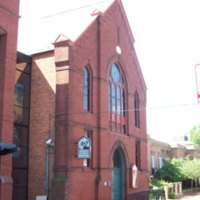
Banneker-Douglass Museum
Formerly the Mount Moriah African Methodist Episcopal Church, the site was constructed in 1875 and opened as the Banneker-Douglass Museum (BDM) in 1984. It was named after Benjamin Banneker – a free-born African American scientist and mathematician. He protested strongly against slavery, and compared the fight of the colonists to that of the enslaved people in America when writing to Thomas Jefferson in 1791. The other namesake was Frederick Douglass, a political activist, writer, and famous abolitionist who documented his experiences both escaping from and fighting against slavery. The museum is dedicated to preserving Maryland’s African American Heritage. It contains a range of both permanent and temporary exhibitions. In light of this legacy, the BDM focuses on a community-based approach to building collections and exhibitions and in providing tours, public programs, and other services. The museum's permanent exhibition is a celebration of African Americans in Maryland; providing an overview of African American history in Maryland from 1633 to the present day. Specifically the exhibition looks at Maryland’s first African American settler, Mathias De Sousa. It includes Benjamin Banneker’s almanacs, used as an anti-slavery protest to Thomas Jefferson, as well as a recording of Frederick Douglass’s speeches against racism and slavery. The museum presently partners with Anne Arundel County Public Library, offering programs and workshops at AACPL branches. It also offers guided tours of both the permanent and temporary exhibition.
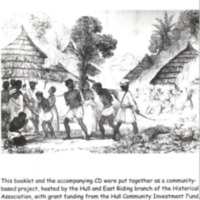
Songs of Slavery
The Songs of Slavery CD and booklet were produced by a community-based project, led by the Hull and East Riding branch of the Historical Association. The project was part of the Wilberforce 2007 initiative in Hull. Songs of Slavery recorded 19 songs relating to slavery, alongside six short narratives. Most of the songs date from the mid-19th century and were originally composed and sung by enslaved peoples. Some were based on religious beliefs, others also contained coded messages to aid escape and resistance. The Songs of Slavery tracks were sung or narrated by local choirs, singers and musicians, together with students from local schools and colleges.
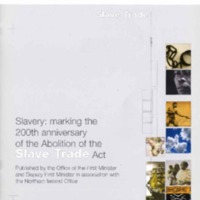
Slavery: marking the 200th anniversary of the Abolition of the Slave Trade Act
The official publication from the Office of the First Minister and Deputy First Minister in association with the Northern Ireland Office, based on the research of historian Nini Rodgers.
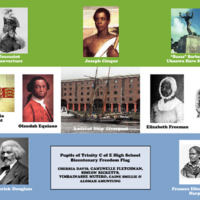
Bicentenary Freedom Flag
The Bicentenary Freedom Flag was displayed alongside an exhibition about Wartime Black History at Manchester Town Hall. The project was a collaboration between staff from Manchester City Council Corporate Services Black Staff Group and pupils of Trinity Church of England School in Manchester. The flag recognised the work, struggles and sacrifices of those who brought the slave trade to an end, and featured images of prominent individuals on the background of the Sierra Leone flag. Those featured on the flag included Toussaint L'Ouverture (General of the Haitian Uprising), the abolitionist Olaudah Equiano, the anti-slavery orator Frederick Douglass, the statue in Barbados of 'Bussa', the unknown slave, guide of the Underground Railroad Harriet Tubman, and Joseph Cinque, leader of the Amistad slave ship revolt. The accompanying exhibition included pupils' articles and creative writing. It also examined the history and role of the West India Regiments, British colonial infantry regiments largely recruited amongst freed slaves from North America and slaves purchased in the West Indies.
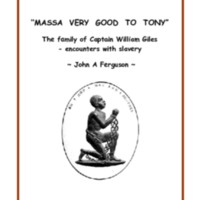
“Massa Very Good to Tony” The family of Captain William Giles - encounters with slavery
A lecture given to the Cumbria Family History Society Annual Conference in November 2007 was produced in booklet form and deposited in the Cumbria Record Office at Carlisle. To mark the bicentenary, John A. Ferguson researched the story of a former slave from Jamaica who lived in Cumberland. Captain William Giles of the British Army served in the West Indies in the 1780s, settling with his family in Jamaica. When the family returned to England, they brought with them James Anthony, known as "Tony", their former domestic slave. Tony was later servant to several other families in Carlisle, and is buried in St Mary's churchyard.
![Paul Thomas Minnihan, I Dare to Dream, 3353 W 13th St [Black Neighborhood], Chicago, 1995.jpg Paul Thomas Minnihan, I Dare to Dream, 3353 W 13th St [Black Neighborhood], Chicago, 1995.jpg](https://486312.frmmmguz.asia/files/square_thumbnails/b2254bc5fe1b092ee4f9c95af8c1ebf3.jpg)
I Dare to Dream
I Dare To Dream is a Chicago mural painted in 1995 by artist Paul Thomas Minnihan. Drawing heavily upon local history, the mural includes locals such as the Chicago Bulls player Michael Jordan, astronaut and first African American woman to travel into space, Mae C. Jemison, and Harold Washington, the first African American mayor of Chicago. Alongside the Chicago figures are the faces of Mary McLeod Bethune, Frederick Douglass and Martin Luther King Jr. The west side mural was situated opposite the Douglass Branch of the Chicago Public Library, but no longer exists.
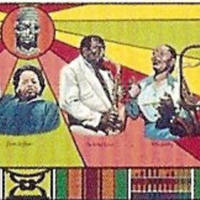
Baltimore Wall of Pride
The Baltimore Wall of Pride stands in the playground at Carey and Cumberland streets in the area of Sandtown-Winchester, Baltimore, Maryland. Painted in 1992 soon after the Rodney King riots of LA, the mural became a site for protest meetings after Freddie Gray was killed in 2015, just blocks away from the mural.Painted by Pontella and Deborah Mason, the mural celebrates the heroes of black history, including Fannie Lou Hamer, James Baldwin, Marcus Garvey, Martin Luther King Jr., Kwame Nkrumah, Charlie Parker, John Coltrane, Langston Hughes, and the antislavery figures Frederick Douglass, Sojourner Truth and Harriet Tubman.
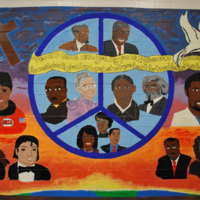
Saint Sabina Mural
In 2011, Chicago-based muralist Lavernon Spivey painted a mural with Howard University students at the Saint Sabina Catholic Church in Chicago’s southside. The mural depicts African American heroes both local and national, past and present, including the antislavery figures Frederick Douglass Harriet Tubman, and also Mae C. Jemison, Barack Obama, Harold Washington, Martin Luther King Jr., Michael Jackson, Michelle Obama, Rosa Parks and Shirley Chisholm. The mural also includes a passage form John 14:27 that reads, “Peace I leave with you, my peace I give unto you not as the world giveth, give I unto you, let not your heart be troubled, neither let it be afraid.”
![Nelson Stevens, Centennial Vision, Tuskegee University Administration Building, AL, 1980 [destroyed].jpg.gif Nelson Stevens, Centennial Vision, Tuskegee University Administration Building, AL, 1980 [destroyed].jpg.gif](https://486312.frmmmguz.asia/files/square_thumbnails/1a0ef8af8ec25559e5c2c7c66502ba40.jpg)
Centennial Vision
In 1980, on the anniversary of the founding of the Tuskegee Institute, AfriCOBRA member Nelson Stevens created a mural to celebrate the occasion. Although Stevens was commonly an exterior mural painter, he created this mural on the inside of the Tuskegee University Administration Building. The mural contains the images of black history figures such as Booker T. Washington (former president of Tuskegee University), General Chappie James and the Tuskegee airmen of World War II, Cinque, Malcolm X, Martin Luther King Jr., and George Washington Carver, as well as the antislavery figures Harriet Tubman, Sojourner Truth and Frederick Douglass. Also included in the image is a phrase made famous by the African scholar John S. Mbiti, “I Am Because We Are.” This mural no longer exists.
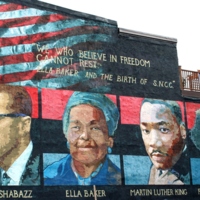
Freedom School
In 2002, with support from the Freedom School Mural Arts Project, Parris Stancell created a mural in West Philadelphia titled Freedom School. The mural sets the faces of Malcolm X, Ella Baker, Martin Luther King Jr., and Frederick Douglass against the backdrop of the American and Black Liberation flags. It depicts Douglass in his younger years, and refers to Malcolm X as Malcolm Shabazz – a composite of his names in the latter years of his life; Malcolm X and el-Hajj Malik el-Shabazz. The mural also champions women's activiism through Ella Baker’s quotation, “We who believe in freedom cannot rest.”
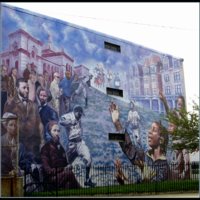
Leidy School Mural
John Lewis and Delia King’s Leidy School Mural is in West Phildelphia. Painted in 2004, the mural fuses history with contemporary scenes of children playing. The young African American children to the right-hand side of the mural are positioned inwards, absorbing the history of their city. The antislavery leader, Frederick Douglass, looks out to the viewer.
![Anonymous, West 116th Street at 8th Ave, Harlem, NYC, 2007 [destroyed].jpg Anonymous, West 116th Street at 8th Ave, Harlem, NYC, 2007 [destroyed].jpg](https://486312.frmmmguz.asia/files/square_thumbnails/68ba2c99969cfee543cc2473ef6ae0da.jpg)
If There is No Struggle
This mural was painted by an anonymous artist around 2007 and no longer exists, but is an important example of both the ephemeral and guerrilla nature of murals: some last for short periods of time on buildings and streets in communities. This particular mural was created in West Harlem and focused on the abolitionist Frederick Douglass. Borrowing his famous phrase from 1857, “If there is no struggle, there is no progress,” the muralist also adds a drumming figure to the centre of the mural.
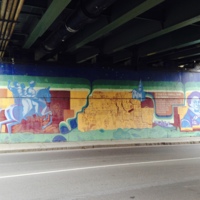
Tubman and Douglass
In 2010 the Brooklyn-based muralist Jonathan Matas created a mural on Green Street in Ithaca under the Aurora Street Bridge. The 30 x 600 foot mural was approved by the Public Arts Commission and depicts Frederick Douglass and Harriet Tubman. “I think it’s a great introduction to our city,” Ithaca Planning and Development Director JoAnn Cornish said. But this was not the general consensus around the mural. The name, 'Comrade Tubman' given to Harriet Tubman on the mural has been a point of controversy for the local community. Tompkins County historian and author Carol Kammen observed: “The word comrade is historically inappropriate and anachronistic."
![Marianne DiNapoli-Mylet, Looking Back, A History of the Black Press, 617 Liberty Street [Chronicle building], Winston-Salem, NC, 1998.jpg Marianne DiNapoli-Mylet, Looking Back, A History of the Black Press, 617 Liberty Street [Chronicle building], Winston-Salem, NC, 1998.jpg](https://486312.frmmmguz.asia/files/square_thumbnails/e0cc2766c734172616139639b01f1af0.jpg)
Looking Back, A History of the Black Press
In 1998, Ernie Pitt, the editor of the Winston-Salem Chronicle, requested a mural that depicted the black press in the United States. Responding to his request, muralist Marianna DiNapoli-Mylet, created Looking Back, A History of the Black Press on the Winston-Salem Chronicle building, In the mural, she shows the history of the black press from 1700 through to the 1960s. The mural features Frederick Douglass most prominently in the centre, with other individuals including W.E.B. Du Bois on the periphery.
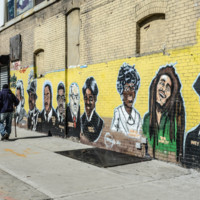
Bed-Stuy Mural
In 2009, the NYC Justice Corps created a mural on Nostrand Avenue and Herkimer Street in Bedford-Stuyvesant, Brooklyn. The NYC Justice Corps was created as part of the city’s strategy to combat poverty and has the mission to “develop the capacity of neighborhoods to address the reintegration challenges of their young adults re-entering from the criminal justice system, and to instil in those young adults a sense of civic responsibility and accountability.”The mural includes the faces of Marcus Garvey, Martin Luther King Jr., Thurgood Marshall, Harriet Tubman, Malcolm X, Shirley Chisholm, Bob Marley and Huey P. Newton, as well as the antislavery figures Harriet Tubman and Frederick Douglass.
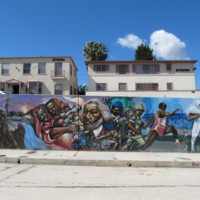
The Crenshaw Wall
In 2000, a graffiti collective called Rocking The Nation (RTN) began The Crenshaw Wall, colloquially known as The Great Wall of Crenshaw. At 7,787 feet long, the mural has become a landmark for the area. The timeline depicts African American history, and features the antislavery figures Frederick Douglass and Harriet Tubman, as well as Marcus Garvey, black soldiers from World War I, II and Vietnam, and Ethiopia’s Emperor Haile Selassie. A shackled slave breaks free from his chains and evolves into an athlete, American footballer and basketball player. Further along the mural are Black Panther Party leaders alongside Martin Luther King Jr., and Malcolm X. The mural starts with a black woman breathing life into the mural and ends with a couple giving birth.“We finally get the chance to paint the Crenshaw Wall, and bring some black awareness to the Crenshaw Wall – to teach the history of our people, to teach our people to be proud, to teach our people love, and where we came from and where we might possibly end up,” explained Enk One of RTN.Over a decade later, the mural requires restoration and protection. RTN are working towards this goal, as well as designating the mural a historical landmark, renaming the block ‘Crenshaw Mural Square’ and developing an app that gives a visual tour of the mural.
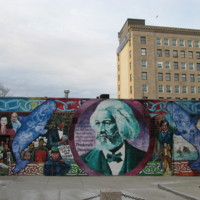
Labor History Mural
This mural in New Bedford titled Labor History Mural and painted by Irish muralist, Dan Devenny, is a short distance away from where Frederick Douglass first lived in freedom. It is on a wall near the Bristol County Probate Court.On September 18, 1838, Douglass settled here in New Bedford after escaping from slavery in Maryland, with the help of his soon-to-be wife, Anna Murray. It was in New Bedford where Douglass experienced, for the first time, what it was like to live as a free man. His abolitionist identity started to take shape. He read his first copy of The Liberator, became a licensed preacher, gave a speech in 1839 that denounced the proposal that free slaves be forced to emigrate back to Africa, and was hired as an agent by the Massachusetts Anti-Slavery Society (MASS). In 1841, after attending a regional convention for the followers of William Lloyd Garrison, Douglass felt compelled to speak about his time in bondage. Inspiring the Garrisonian audience, he was shortly recruited as a lecturer for MASS. “Many students in New Bedford never learn of the importance of Frederick Douglass and his relation to the civil rights movement and this city,” said Massachusetts Senator Mark Montigny. “This mural will be a constant reminder of his prominent leadership and what he means to New Bedford.”
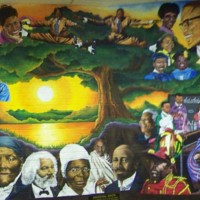
Ancestral Roots
Pontella Mason is one of Baltimore’s unsung visual artists. He has created murals for the Anacostia Community Museum, former President Jimmy Carter, and several other public organisations. His murals depict African American life and the diaspora. In 1999, he created the extensive mural Ancestral Roots, which depicts the antislavery heroes Harriet Tubman, Sojourner Truth, and Frederick Douglass, as well as Martin Luther King Jr., Malcolm X, Muhammad Ali, Notorious B.I.G., Tupac, Shirley Chisholm, and Marcus Garvey.
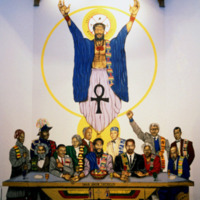
Last Supper
In 1990, muralist Maurice Myron Jenkins created an alternative version of Leonardo da Vinci’s 1494 fresco The Last Supper. The 30 by 19 foot mural depicts the last supper with a black Christ and 12 historical black figures as the prophets. Jenkins chose the Union Temple Baptist Church in Anacostia, Washington D.C. as his canvas because of its role in black history all the way back to its affiliation with Anacostia-resident Frederick Douglass in the 19th century.The mural includes the antislavery figures of Sojourner Truth and Frederick Douglass, as well as Marcus Garvey, Martin Luther King Jr., Rosa Parks, Elijah Muhammad, Malcolm X, Mary McLeod Bethune, Nelson Mandela, Booker T. Washington and W.E.B. Du Bois.
![Mary Patten, Douglass Street Mural, 389 Douglass St, Brooklyn, NY, 1976 [destroyed 1989].jpg Mary Patten, Douglass Street Mural, 389 Douglass St, Brooklyn, NY, 1976 [destroyed 1989].jpg](https://486312.frmmmguz.asia/files/square_thumbnails/95232a9ffb9e9bde28fc73b69fc9109a.jpg)
Douglass Street Mural
Mary Patten painted Douglass Street Mural – Cityarts Workshop’s first Brooklyn-based project – in 1976. Over a five-month period, Patten led a group of 20 teens and adults to develop various themes for the mural that would be located on Douglass Street in the Park Slope area of Brooklyn - an area more commercial than residential at the time. Community meetings and bilingual flyers filled the neighbourhood in the hope of garnering community input and consensus over the choice of imagery. The three-storey mural takes advantage of the building's structure by presenting the image as book pages waiting to be read. The dystopian nightmare to the right-hand side of the mural attempts to encroach on the multicultural utopian melting pot to the left, only to be fended off by workers and important figures from U.S. history. Folded into the Puerto Rican flag and the red, white and green banner of the African National Congress, are the images of Harriet Tubman, pointing towards the nightmare-scape, alongside Frederick Douglass, Lolita Lebrón, Malcolm X and H. Rap Brown. Under the imperialist eagle and puppet-like figure in its talons, Patten depicts a recent firebombing that had destroyed the homes of several Black families a few blocks away. Speaking of the large rainbow in the image, the muralist incorporated it to show "what is possible when people work and fight together to create what we need: a community school that provides quality education; people sharing skills and tools; dancing together; making music and painting a mural."The mural sought to convey hope and determination in the face of oppression. But by the 1980s, the mural had become obscured by new housing developments.